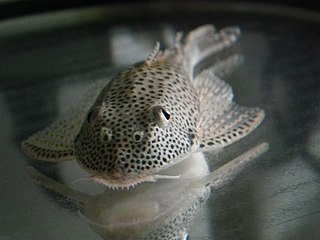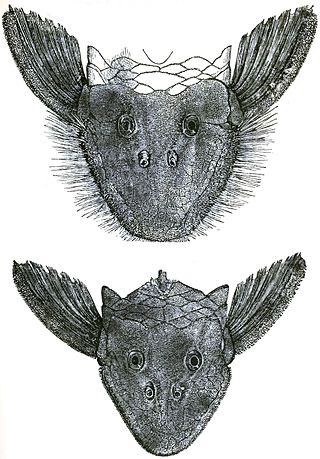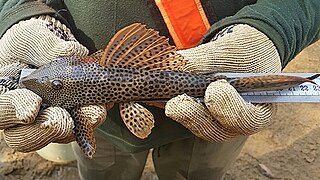
Ancistrus is a genus of nocturnal freshwater fish in the family Loricariidae of order Siluriformes, native to freshwater habitats in South America and Panama. Fish of this genus are common in the aquarium trade where they are known as bushynose or bristlenose catfish. In the aquarium hobby they are often referred to as bushynose or bristlenose plecos instead, but this may lead to confusion as "pleco" usually is used for Hypostomus plecostomus and its allies and is often used as a catchall term for any loricariids remotely resembling that species.

Hypostomus is a genus of catfish in the family Loricariidae. They are native to tropical and subtropical South America. H. plecostomus is the popular freshwater aquarium fish formerly known as Plecostomus plecostomus. The taxonomic structure of the Loricariidae is still being expanded by scientists. Hypostomus is a highly species-rich and widely distributed catfish genus.

Pterygoplichthys, sometimes collectively known as janitor fish, is a genus of South American armored catfishes. These fish are commonly known as sailfin armoured catfish or sailfin plecs, especially in the aquarium trade.

Aphanotorulus is a genus of armored catfishes native to the Amazon, Orinoco, Essequibo and Jaguaribe basins in South America. They typically occur on a sand or gravel bottom in slow to moderately flowing rivers and streams, but some species occur in areas with fast current. The largest species in the genus reaches up to 51 cm (20 in) in standard length.

Pseudancistrus is a genus of suckermouth armored catfishes native to South America.

Peckoltia is a genus of small South American armored suckermouth catfishes. Many of these fish are popular aquarium fish.

Hemiancistrus is a genus of suckermouth armored catfishes. These species are native to South America. The taxonomy of this genus is complex and unclear, and major work has to be done. Many of these fish are popular aquarium fish.

Farlowella is a genus of fish in the family Loricariidae native to South America. This genus is broadly distributed in Amazon, Orinoco, Paraná and coastal rivers of the Guyana Shield. It is absent from the Pacific slope of the Andes and from the coastal rivers of the Brazilian Shield. Many of these species are kept in aquariums. This genus has a unique body shape that resembles a thin stick of wood. The body is slender and elongate, often with a pronounced rostrum and a brownish color with two lateral dark stripes beginning at the tip of the rostrum, passing over the eyes and ending at the tail, which are periodically interrupted on the caudal peduncle.

Pseudacanthicus is a genus of medium to large-sized suckermouth armored catfishes native to South America, where found in the Amazon and Orinoco basins, as well as rivers of the Guianas. They are primarily found in fast-flowing waters, sometimes relatively deep. They are sometimes kept in aquariums.

Chaetostoma, also known as the bristlemouth catfish, is a genus of suckermouth armored catfishes native to South America with one species, C. fischeri, extending into Panama. Most species inhabit flowing rivers in the lower Andes and its foothills. Some species are kept in unheated aquaria.

Isorineloricaria spinosissima, also known as the zucchini catfish, is a species of Loricariidae endemic to the Guayas River basin in western Ecuador. This species grows to a length of 56.5 centimetres (22.2 in) TL.
Aphanotorulus ammophilus, also known as the black spotted pleco, is a species of benthopelagic tropical freshwater catfish in the family Loricariidae native to Venezuela and Colombia, specifically the Río Orinoco drainage. Due to an initial erroneous publication, A. ammophilus was initially placed into Hypostomus instead of Aphanotorulus. However, because this species shows sexual dimorphism, has a relatively flatter shape, and has a jagged posterior edge of its oral disc, it was placed in the genus Aphanotorulus. It sometimes appears in the aquarium trade, where it is known as the cute pleco, although it may be referred to by its L-numbers, L094 or L123. A. ammophilus reaches 16.1 cm (6.3 in) SL.

Aphanotorulus emarginatus is a species of catfish in the family Loricariidae. It is native to South America, where it occurs in the Amazon River basin. The species reaches 15 cm (5.9 in) in total length. It is known to be a facultative air-breather.
Aphanotorulus gomesi is a species of catfish in the family Loricariidae. It is native to South America, where it occurs in the Jaguaribe River basin. The species reaches 14.3 cm SL. It is thought to be a facultative air-breather.
Aphanotorulus horridus is a species of catfish in the family Loricariidae. It is native to South America, where it occurs in the Madeira River basin. The species reaches 35.5 cm SL. It is thought to be a facultative air-breather.
Aphanotorulus phrixosoma is a dubious species of catfish in the family Loricariidae. It is native to South America, where it occurs in the upper Amazon River basin. The species reaches 10.1 cm (4 in) SL. It is believed to be a facultative air-breather.
Aphanotorulus unicolor is a species of catfish in the family Loricariidae. It is native to South America, where it occurs in the upper Amazon River basin. The species reaches 13.9 cm SL.
Isorineloricaria acuarius is a species of catfish in the family Loricariidae. It is native to South America, where it occurs in the Apure River basin in Venezuela. The species reaches at least 26.9 cm in standard length. It was described in 2016 as part of a taxonomic review of the genera Aphanotorulus and Isorineloricaria conducted by Jonathan W. Armbruster and C. Keith Ray. FishBase does not yet list this species.
Isorineloricaria tenuicauda is a species of catfish in the family Loricariidae. It is native to South America, where it occurs in the Magdalena River basin in Colombia. The species reaches 45 cm in standard length, can weigh up to at least 960 g, and is believed to be a facultative air-breather.
Isorineloricaria villarsi is a species of catfish in the family Loricariidae. It is native to South America, where it is known only from Venezuela. The species reaches 32 cm in standard length and is believed to be a facultative air-breather.












